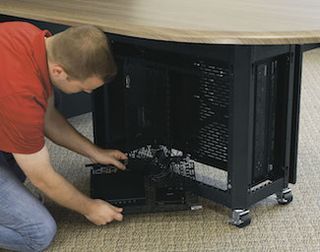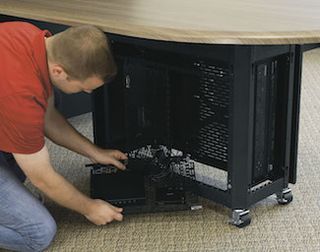Sure, we all have dreams, and as an integrator, one could be that mega, blue-sky project. But while we wait for that project, it’s time to embrace those everyday projects that keep your business running because, after all, those represent a dream fulfilled. The trick is to maximize these opportunities without slipping into autopilot mode in a way that can hinder sales and client satisfaction.

Timothy Troast, director of product management at Middle Atlantic Products, said during the initial client meeting, it is important to understand what your client is trying to accomplish, and to leverage the brands you know, when working with every day installations.
Focusing on the client’s objectives is critical, maintained Timothy Troast, director of product management, Middle Atlantic Products. “The opportunity here is during the initial meeting with the customer, where the specifics of their application are revealed and explored. It’s important to understand what the client is trying to accomplish, and to leverage the brands you know, trust, and can modify to meet their requirements. This prevents autopilot mode from setting in and really provides integrators with an opportunity to show the client what they can do.”
Successful integrators, he said, will reuse proven designs when possible and will depend on systems that are well-documented for maximum efficiency. “By standardizing on a handful of proven products and services that are flexible and scalable, integrators can create a repeatable process while still offering a customized solution based on the specific application. This ensures that budgets and schedules are maintained to maximize profits, while delivering the best possible AV experience for their client.”
At BTX Technologies, the most successful integration customers will look at a “run-of-the-mill” job as an opportunity to deepen a customer relationship and to plant seeds for future business opportunities, explained company president/CEO Greg Schwartz. “For instance, while on-site, why not ask the client if they have trouble zones with their cell signal? It could open the door to selling cell signal boosting technology. Or, if in a classroom environment, why not ask about lecture capture and collaboration? Discussing these more unique solutions could broaden the client’s understanding of what a good AV integrator can provide them. And for the integrator, partnering with the right vendor is a key strategy for success.”
Clark Brown, vice president of sales, LG Electronics USA commercial displays, emphasized that integrators will prove successful if they treat each project, regardless of the scope, as a joint collaboration with the client, while focusing on the most effective solution to drive business and increase the clients’ bottom line. “Additionally, client satisfaction will always be achieved by pushing aside the belief that any project is run-of-the-mill, instead, focusing on the personalized strategic effort that each project requires from start to finish.”
And although most rooms will be very different, being able to pull from a library of equipment and rack layouts that are easy to modify can speed up the quote, sales, and integration processes while ensuring that best practices and design guidelines are followed, Troast added. “To save more time and money, if integrators are using a configured equipment enclosure, they should leave it to the factory to do the work. However, it’s important not to forget that pre-configured racks should also incorporate proper thermal management and power protection.”
Since no two customers and applications are exactly the same, it is the savvy integrator who hears the subtle difference between this project and the last, and who acts on this information to develop a unique solution, he continued. “If an integrator doesn’t have the time to create a unique solution, they can still use their resources to the benefit of the client. Manufacturers often send sales reps to integrators for demonstrations of their latest products. If a new product fits the bill, integrators can ask manufacturers for help in designing it into their project. It’s a good way to gain experience with new technology, while saving time and possibly increasing profits. And of course, it’s always a good idea to have ‘good, better, and best’ alternatives lined up for specific products to allow for quick and easy swap-outs.”
Trending Technology
“In the display area, the growing trend we’re seeing are smarter interfaces that assist with installations,” Brown said. “For example, in 2015, LG’s Smart Platform Signage solution running webOS allows system integrators to download useful content and develop customized applications that fit their exact needs. With webOS, LG’s Smart Platform Signage can be updated immediately via a smartphone or tablet. Wi-Fi connectivity eliminates the need for a wired connection or costly network infrastructure.”
As a leading commercial manufacturer, LG products provide a simple and effective solution that drives business and increases clients’ bottom lines, he noted. “For instance, successful integrators narrow in on the exact solution the client needs to help run its business efficiently. It goes beyond providing a piece of new technology, and instead focuses on the best overall solution that will meet their needs to achieve business success.”
One tremendous technology trend that has caught fire is the use of collaboration systems, not only for educational institutions, but for any organization that benefits from teamwork, Sandri said. “Integrators have used FSR’s HuddleVU system, which allows multiple users to share and view their laptops, tablets, and smartphone screens on a main display, to drive creative collaboration and guard against slipping into stale routines. We hope these systems help turn every ordinary install into a customized project via fresh ideas and shared inspiration.”

Middle Atlantic illustrates how changing form factors are driving the ability to mount devices in new and discreet places, like within the table support (Frame to Furniture).Form factors evolve with technology, Troast explained. “If integrators aren’t looking for new ways to mount devices—whether under-table or in-ceiling—they may be missing out on an opportunity to do it in a smaller, more efficient, and ultimately more profitable way. The Wiremold Evolution Series ceiling box features integrated power and cooling, while the C2G RapidRun modular cable system offers the ability to change out leads, and Middle Atlantic’s Frame to Furniture products allow integrators to update and potentially upgrade furniture finishes for clients down the road.”
Signal extension has also come a long way, with IP distribution becoming easier as AV has evolved from analog to digital. “Wireless systems are becoming more cost effective and easier to deploy, while requiring less programming,” he added. “The IoT (Internet of Things) movement has also grown into the IoE (Internet of Everything) movement, and the more devices connected, the better the understanding integrators will have of the systems they install. This will lead to a continuous feedback loop of information from the customer, to the installer, to the manufacturer, enabling a new age of AV services and the ability to harness big data to create new and improved experiences for clients.”
That’s a One-Stop, or Not
One-stop shops are great when all the products are appropriate for the client’s requirements and budget, especially when the system can be assembled, programmed, and delivered ready to install, Troast explained. “Smaller everyday projects don’t call for cheap products or ‘hang and bang’ installations. Like any project, they require installs to be efficient while delivering a reliable, easy-to-use system. While there are exceptions, one-stop shop vendors who provide a wide range of products are also more likely to offer a wider product breadth, where the choice between ‘good, better, and best’ solutions can make a big difference in satisfying the client, both in terms of their AV experience and budget.”
And to be more competitive, one-stop shops are delving into deeper portfolio offerings instead of focusing on just one product category, he concluded. “They are also getting savvy with things like assembly, unique part numbers, and easy online ordering. In addition, many are offering compelling programs that are driving integrators to consolidate their buying to maximize profits. All of this means less time spent—and more money saved—by integrators shopping around for products and managing vendors.”
Karen Mitchell is a freelance writer based in Boulder, CO.

